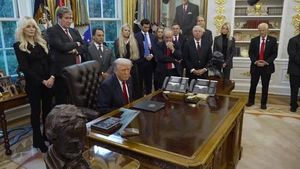On October 10, 2025, President Donald Trump’s administration took the unprecedented step of firing thousands of federal employees in the midst of a government shutdown, marking a dramatic escalation in the ongoing standoff between the White House and congressional Democrats. According to a court filing and multiple statements from administration officials, more than 4,000 federal workers received layoff notices on Friday, as the Trump administration began implementing broad reductions in force across several federal departments and agencies. The move, which the White House had threatened for days, represents a significant break from how previous shutdowns have been managed, with critics and unions decrying it as an abuse of power and a deliberate attempt to leverage the shutdown for political gain.
Russell Vought, Director of the White House Office of Management and Budget, made the announcement public with a brief message posted on X (formerly Twitter): “The RIFs have begun.” The term refers to “reductions in force,” a formal process for laying off federal employees. Vought had warned the previous week that “consequential” layoffs were imminent if the shutdown dragged on. By Friday evening, according to a Justice Department court document, about 4,000 federal workers had already received RIF notices, and senior administration officials signaled that additional layoffs were likely in the coming days.
The initial wave of layoffs affected employees at seven key federal departments: Commerce, Education, Energy, Health and Human Services (HHS), Housing and Urban Development, Homeland Security, and Treasury. The Treasury and HHS departments saw the largest impacts, with each losing more than 1,000 workers. The Commerce Department, Education Department, and Housing and Urban Development also saw hundreds of layoffs each. Other agencies, such as the U.S. Patent and Trademark Office and the Environmental Protection Agency (EPA), issued either direct or “intent to RIF” notices, with the EPA still deliberating final decisions on layoffs. Additional departments, including the Interior Department, are actively considering further reductions.
The Trump administration’s move comes as the government shutdown, which began on October 1, 2025, entered its tenth day with no signs of resolution. The White House has repeatedly blamed congressional Democrats for the impasse, insisting that their refusal to agree to Republican demands—particularly around Medicaid cuts and health care policy—left the administration with little choice but to act. However, as CNN reported, the decision to initiate mass layoffs during a shutdown is not required by law and has not been carried out in past shutdowns. Historically, nonessential workers have been furloughed, meaning their pay is paused but their jobs are not terminated. This time, about 750,000 federal workers have been furloughed, but the layoffs mark a sharp departure from established precedent.
President Trump himself was unapologetic about the move. Speaking late Friday afternoon, he said, “We figure they started this thing, so they should be Democrat-oriented,” asserting that the layoffs would target workers he deemed aligned with the Democratic Party. He added, “We’re going to be cutting some very popular Democrat programs that aren’t popular with Republicans, frankly, because that’s the way this works. They wanted to do this, so we’ll give them a little taste of their own medicine.”
The administration’s actions quickly drew fierce criticism from union leaders, legal experts, and Democratic lawmakers. The American Federation of Government Employees (AFGE) and the American Federation of State, County and Municipal Employees, two of the largest unions representing federal workers, filed a lawsuit on September 30, 2025, in anticipation of the layoffs. The suit, as reported by USA TODAY, argues that firing workers during a shutdown is an abuse of executive power that strips federal employees of their rights to back pay and violates agencies’ statutory duties. On Friday, union attorneys filed for a temporary restraining order in federal court, seeking to halt the layoffs immediately.
“It is disgraceful that the Trump administration has used the government shutdown as an excuse to illegally fire thousands of workers who provide critical services to communities across the country,” said AFGE National President Everett Kelley in a statement. Skye Perryman, CEO of Democracy Forward and an attorney for the unions, responded to Vought’s announcement by posting, “We will see you in court.”
Democratic leaders on Capitol Hill were equally blunt. Senator Patty Murray of Washington, the top Democratic appropriator in the Senate, wrote on X, “Once again: if President Trump & Russ Vought decide to do more mass firings, they are CHOOSING to inflict more pain on people. ‘Reductions in force’ are not a new power these bozos get in a shutdown. We can’t be intimidated by these crooks.” Senate Democratic Leader Chuck Schumer echoed the sentiment, stating, “Nobody’s forcing Trump and Vought to do this. They don’t have to do it; they want to,” and accused the administration of “deliberate chaos.”
Even as the White House insists the layoffs are necessary to preserve essential services and funding, many observers see a political calculus at work. According to Politico and CNN, the layoffs fulfill President Trump’s long-standing campaign promise to “cut vast numbers of people out” of the federal workforce and to slash programs he claims are favored by Democrats. The administration has been planning for widespread reductions in force since early in Trump’s term, including incentive programs for voluntary departures. As of late September 2025, more than 201,000 civil servants had already left federal service, according to the Partnership for Public Service.
Max Stier, CEO of the Partnership for Public Service, criticized the administration’s actions, telling CNN, “There is no extra legal authority on their part to conduct RIFs on the basis of a shutdown.” He warned, “These unnecessary and misguided reductions in force will further hollow out our federal government, rob it of critical expertise and hobble its capacity to effectively serve the public.”
The process for layoffs, or RIFs, typically calls for termination within 30 to 60 days of receiving notice. However, the abruptness of the move during a shutdown has left many federal workers confused, especially those who are furloughed and have limited access to their work email. Administration officials have said affected employees will also be notified by the U.S. Postal Service, which remains operational during the shutdown. The White House has clarified that furloughed workers may use government-issued equipment to check for RIF updates.
As the shutdown grinds on and the legal battle over the layoffs intensifies, the fate of thousands of federal workers—and the broader implications for the government’s ability to function—hangs in the balance. With both sides entrenched and the courts now involved, the coming weeks may determine not only the outcome of this historic standoff but also set a precedent for how future shutdowns are managed in Washington.




